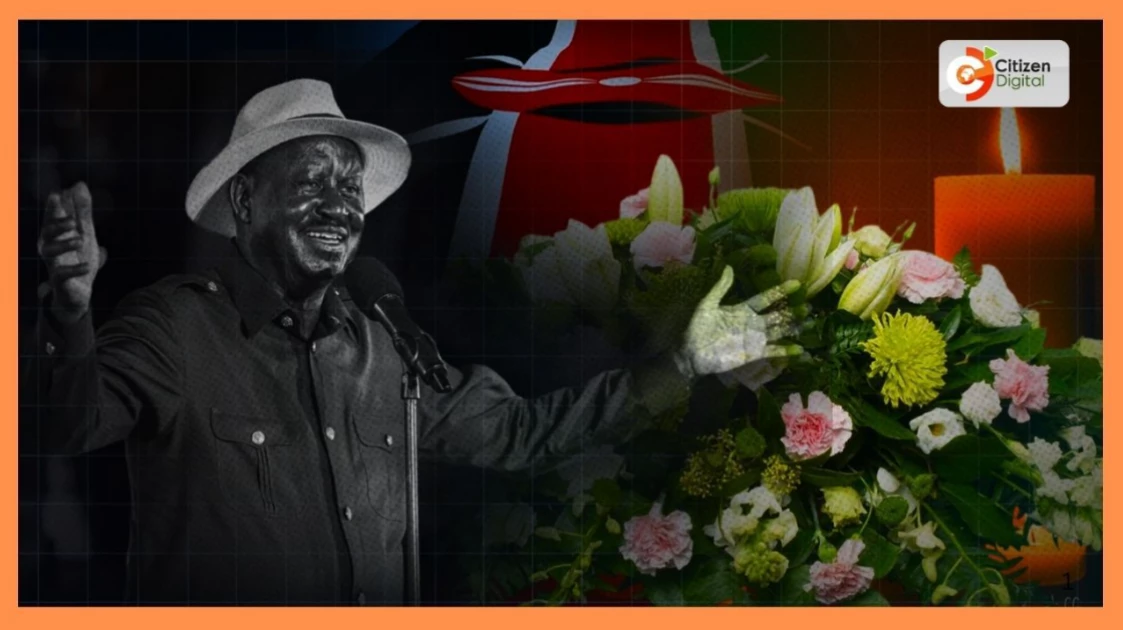Inside Raila Odinga’s final journey: A blend of State protocol and Luo traditions


Audio By Vocalize
Despite the fact that it is a State
funeral, Raila Odinga’s final journey has been characterised by cultural
practices associated with Luo funeral ceremonies.
From the breaking of the news of
death, to identifying the burial site, wailing to mourn the dead to cleaning of
the homestead after burial, the Luo community has a unique way of showing the
last respects to their departed loved ones.
A tradition held in high regard
for generations that has since played out in the final journey of Raila Odinga;
a man of great stature, an elder and a celebrated icon within the larger Nyanza
region.
Soon as news of the death of
former Prime Minister Raila Odinga broke, friends, family, relatives and
thousands of his supporters broke in wailing as an expression of intense grief
and deep emotional pain. A death wail; a significant part of the Luo customs
and traditions of sending off a departed soul.
A funeral ceremony, popularly
known as ‘Liel’ in the Luo community, is held in high regard because Luos
consider death an important part of somebody ’s life.
Though culture has been greatly
influenced by geographical position, religion and modernization, certain
critical steps must be followed in Luo rituals of death.
The first stage is the death
announcement known as ‘Kelo ywak,’ where a selected member of the family
officially brings the news of death to officially open the home for mourning.
After the acceptance that death
has occurred, an important meeting is held by the close relatives commonly
known as ‘Anyuola’ to discuss the burial plans. Critical aspects like the burial
site, date and rites to be performed are agreed upon.
Once the burial site is identified,
the digging of the grave begins the process is called ‘Kunyo.’
Raila Odinga’s family agreed to
bury him near his late father Jaramogi Oginga Odinga, at the Kang’o Ka Jaramogi
homestead in Bondo.
His elder brother and Siaya
Senator Oburu Odinga, as per tradition, represented the family as the first to
dig the grave. Selected young men in the village would then take over and
finish the digging of the grave.
Back in the day, bodies were not
taken to the mortuary so the mourners would kick start vigils also known as ‘Budho’
as they wait to bury the departed.
But with modernization, the vigils
would continue at the homestead of the departed as his/her body is preserved at
the mortuary.
Luo funerals, especially for a man
of the stature of Raila Odinga, can take possibly between 3 - 4 weeks. It is no
wonder his 72-hour timeline for burial came as a shock to many.
When the family is ready for the
burial, the body is usually removed from the mortuary a day before the burial
date in a ceremony known as ‘Golo.’
‘Golo’ is simply a funeral
procession to the homestead of the late where mourners turn out in their
numbers for this final journey, wailing, chanting praises and carrying leaves
typically known as ‘Oboke’ to express their grief.
This is followed by the viewing of
the body, which is held in high regard within the Luo community, for mourners
to find closure and believe that indeed death has occurred.
The timelines for Raila Odinga’s
funeral procession may have varied considering his stature in the country,
which meant that the committee in-charge of his burial had to factor in the
logistics of ferrying his body from India to Siaya and the long duration it
would take for thousands of his supporters to view his body before burial.
Once the body has been received at
the homestead, an overnight vigil characterised by a bonfire will be held to
signify the last time the dead will be spending time with his relatives.
The next day, the burial ceremony -
‘Iko’ - takes place where mourners finally send off their loved one. This is
done depending on the gender, age and the place the person being buried holds
in the society.
In some instances, depending on
the wishes of the family, there is a traditional ceremony that is done after the
burial known as ‘Tero Buru’ where bulls are driven in the homestead and around
the grave to cleanse the home and chase the spirit of death.
After the burial, some very close
relatives will have to spend some days at the homestead to continue mourning.
But before they finally leave, they may opt to clean the burial site in a
ceremony called ‘Yweyo Liel.’ This is done to appease the departed by leaving
him/her in a clean place.
Despite the aura of grief, Luo
funerals are also characterised by a lot of song, dance and plenty of food for
mourners.
It is no wonder community members
and friends of the family usually donate food including cows to be slaughtered
to feed guests at the funeral.
Until his death, the former
premier spoke passionately against flamboyant funeral ceremonies that often
leave the bereaved family impoverished. He advocated for a swift burial, and
many say that even in death he has led by example.

Leave a Comment